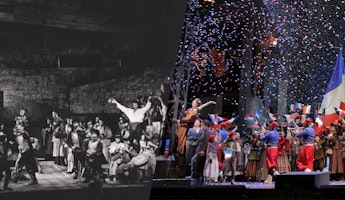Blog
September 13, 2021
New Directions in Azucena: "Il Trovatore"
There is something kind of odd about Il Trovatore. It has an impossible story, a large number of principal roles, and difficult vocal writing. This opera shows Verdi shifting gears; it belongs to a group of three operas that illustrate Verdi’s compositional style moving from his early period into his middle period during the mid-19th century. Il Trovatore, which premiered in January 1853, is the center of his “middle trilogy,” flanked by Rigoletto (March 1851) and La Traviata (March 1853). While it’s a mainstay in the operatic repertoire, it’s not as easily understood as the two operas that bookend it. It’s not hard to see how the heartfelt, more focused dramas around a court jester ill-equipped to protect his beloved daughter (Rigoletto) and a consumptive courtesan whose pure love ennobles her (La Traviata) have gained widespread popularity. Once you finally figure out what happened before the opera even begins (the killing of a migrant Romani woman and infanticide), it’s a difficult narrative to accept. Yet the memorable tunes, riveting music and intense drama continue to draw us in and make diehard fans.
Il Trovatore is a hard opera to cast, with four large roles that are vocally challenging. Coming out of primo ottocento (also known as bel canto) norms that extend back to Rossini, Bellini and Donizetti, the music also begins to exhibit the heavier spinto style that Verdi became known for later in his career. This is especially true for the two female characters. Leonora needs the high flexible coloratura singing of a Gilda (Rigoletto) or Violetta (La Traviata), but there is an additional heft in the role that looks forward to subsequent soprano heroines who must soar over the larger late-Verdian orchestra.
Azucena utilizes a different dramatic style, less reliant on florid acrobatic singing; while she sings lyrical tunes, there are also moments when her line unpredictably jolts across her wide range. She is a mother to Manrico and an unexpected rival to Leonora for her son’s attention. Even with her grisly infanticidal past, Verdi was drawn to this character so much that early on he wanted to name the opera after her. It’s not an overstatement to say that the key to understanding Il Trovatore is to think deeply about Azucena.
“If we cannot retain all the novel and bizarre characteristics of the Spanish play in our vision, it is better to give it up.”*
This is Verdi writing to the renowned librettist Salvadore Cammarano on April 9, 1851, about turning the 1836 Spanish play El Trovador by Antonio García Guttiérez into an opera. Based in Naples at the Teatro San Carlo, Cammarano was senior to Verdi at that time and, arguably, more renowned; he had written many libretti, most famously for Donizetti’s Lucia di Lammermoor. Verdi and Cammarano had collaborated before with Alzira (1845) and, more successfully, with Luisa Miller (1849). They had another project adapting Shakespeare’s King Lear that, alas, was never completed. Il Trovatore was the last project they worked on together; in fact, Cammarano completed the libretto from his deathbed. In their correspondence about earlier projects, Verdi shows great deference to the legendary master. In their letters pertaining to Il Trovatore, we see Verdi feeling more comfortable in asserting his opinions and desire for new directions.
In that same letter to Cammarano (April 9, 1851), Verdi wrote: “If I am not mistaken, some scenes do not have the power and originality they had before and Azucena especially does not retain her strange and novel character: it seems to me that the two great passions of this woman, filial love and maternal love, are no longer present in all their force.”
We see Verdi defending his strong conviction that Azucena needs to retain her unusual and striking nature. Having lived in a time when operatic mad scenes were celebrated (indeed, he wrote what has become the quintessential mad scene in Lucia di Lammermoor), Cammarano wrote for Azucena as through she were part of the primo ottocento tradition. In the same April 9 letter, Verdi wrote:
“Don’t have Azucena go mad. Exhausted with fatigue, suffering terror and sleeplessness, she speaks confusedly. Her faculties are weakened, but she is not mad. This woman’s two great passions, her love for Manrico and her wild thirst to avenge her mother, must be sustained to the end. When Manrico is dead, her feeling of revenge becomes stupendous; and in the utmost agitation she cries ‘Yes, he was your brother!...You fool!...Mother, you are avenged!’”
A few weeks later (April 26, 1851), Cammarano defends his characterization of Azucena, claiming that he remained faithful to the original. He argues:
“As for originality, what have I omitted or added? You don’t want her demented in the final scene? Well then, it is you who wish to deviate completely from the original. [….] The closer the actress seems to be telling the truth, the more Manrico will seem to play the part of an imbecile. The less clearly Azucena reasons, the more rational the drama seems. I don’t intend, by the way, that Azucena be insane at all times; her mind wanders when she recalls the horrendous catastrophes endured by her mother and her son.”*
Even through illness, writing in the final months before he died, Cammarano shows his mastery for how drama works. He predicted that having Azucena firmly rooted in the present would diminish the credibility of Manrico and make him seem like “an imbecile.” With Cammarano, Azucena is rooted in the primo ottocento; however, through Verdi’s conception, she pulls the genre forward.
Today, the power of Azucena experiencing horrific memories of a past that haunt her present can be more easily understood through our discourse around Post-Traumatic Stress Disorder [PTSD]. Through such an interpretation, Verdi and Cammarano shaped a female character who gives voice to unspeakable loss, trauma and pain. In Azucena, they embodied an experience that was prescient of an articulated psychology yet to come.
By making Azucena a principal and central role, Verdi was forging something new and exciting. His convictions continued past the initial creation, as we see in a letter he wrote to his friend and frequent librettist, Francesco Maria Piave, about the possibility of having soprano Marianna Barbieri-Nini sing Leonora in Venice in the spring of 1853. (She had already premiered three Verdi roles: Lucrezia in The Two Foscari, Lady Macbeth and Gulnara in Il Corsaro.)
“If she wants to do Il Trovatore, there’s another part, that of [Azucena]. Don’t talk about the convenienze or say that it’s a comprimaria [bit part]; no, indeed; it’s a principal, the principal role; finer and more dramatic and more original than the other. If I were a prima donna (a fine thing that would be!) I would always rather sing the part of [Azucena] in Il Trovatore.”*
In such a provocative statement, we learn many things (such as different conceptions of voice types and categories between Verdi’s time and ours today—Leonora and Azucena are now sung by very different singers). But more to the point, this letter gives us an encapsulation of Verdi’s feelings about Azucena. Here we see that Verdi thought of her as the leading role, “more dramatic and more original” than Leonora. In fact, in later revisions to the opera, he had to enlarge Leonora’s role, since the traditional soprano heroine did not have enough music. Quite unexpectedly, Verdi admits that Azucena is the role he would have liked to sing. In a dark story with gorgeous writing for all four principals, Azucena shows us a new model of womanhood on the stage that is flawed, yet very human, and perhaps even more relatable today as we have a psychological framework for understanding the haunting confusion of trauma.
NOTES
1 Abbiati, Verdi, vol. 2, 125. English translation by Downes, Werfel and Stefan, Verdi: The Man in his Letters, 166-7.
2 From the critical edition of Il Trovatore (ed. David Lawton), The Works of Giuseppe Verdi, vol 18. 1992, p. xviii. Mossa, “The Genesis of the Libretto” from the Introduction.
3 Grammar (use of semicolons) and emphasis in the original. Abbiati, Verdi, vol. 2, 241. English translation by Julian Budden (Operas of Verdi, vol. 2, (1978) p. 68. Verdi’s original word “la gitana” translates into what is now considered a racialized slur; I have substituted in the character’s name, Azucena, in this translation.
ABOUT THE AUTHOR
Naomi André is a Professor in the Department of Afroamerican and African Studies, Women’s and Gender Studies, and the Residential College at the University of Michigan. She is the author of the award-winning book Black Opera: History, Power, Engagement and a co-editor for the forthcoming essay collection African Performance Arts and Political Acts. She is the inaugural Scholar in Residence at Seattle Opera and a founding member of the Black Opera Research Network.








/03-cosi/_dsc0996_pr.jpg?format=auto&fit=crop&w=345&h=200&auto=format)















